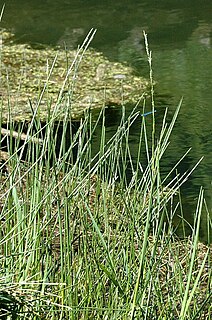
The Cyperaceae are a family of graminoid (grass-like), monocotyledonous flowering plants known as sedges. The family is large, with some 5,500 known species described in about 90 genera, the largest being the "true sedges" genus Carex with over 2,000 species.

Water gardens, also known as aquatic gardens, are a type of water feature. They can be defined as any interior or exterior landscape or architectural element whose primary purpose is to house, display, or propagate a particular species or variety of aquatic plant. The primary focus is on plants, but they will sometimes also house ornamental fish, in which case the feature will be a fish pond.

Scirpus is a genus of grass-like species in the sedge family Cyperaceae many with the common names club-rush, wood club-rush or bulrush. They mostly inhabit wetlands and damp locations.
This article gives an overview of the swamp and tall-herb fen communities in the British National Vegetation Classification system.

Riccia fluitans, whose common name is floating crystalwort, is an aquatic floating plant of the liverwort genus Riccia which is popular among aquarists as a retreat for young fry and is used in live-bearing tanks. It can be found floating in ponds, and often forms thick mats on and under the water surface.

Glyceria fluitans, known as floating sweet-grass and water mannagrass, is a species of perennial grass in the genus Glyceria native to Europe, the Mediterranean region and Western Asia and occurring in wet areas such as ditches, riverbanks and ponds.

Ranunculus fluitans is a species of buttercup. It is a perennial water plant, that when in favourable conditions it can grow up to 6 m (20 ft) height.

Isolepis cernua is a species of flowering plant in the sedge family known by the common names low bulrush, slender club-rush, tufted clubrush, and fiberoptic grass. It is widespread, being native to many regions of the world, including parts of Australasia, Eurasia, Africa, and North and South America.
Isolepis carinata is a species of flowering plant in the sedge family known by the common name keeled bulrush. It is native to North America, where it is mostly distributed around the southeastern United States; it can also be found on the California coast. It grows in many types of moist and wet habitat, including disturbed, cultivated, and landscaped areas. It is an annual herb producing clumps of slender, erect stems up to 25 centimeters tall. The inflorescence is a solitary spikelet just a few millimeters long, or a cluster of up to three spikelets. These are accompanied by a stiff bract which looks like an extension of the stem growing past the spikelets.
Amphiscirpus is a monotypic genus of flowering plants in the sedge family containing the single species Amphiscirpus nevadensis, which is known by the common name Nevada bulrush.

Isolepis setacea is a species of flowering plant in the sedge family known by the common names bristle club-rush and bristleleaf bulrush. It is native to Eurasia and Africa, and possibly Australasia. It can be found in other places, including some areas in North America, where it is an introduced species. It grows in many types of moist and wet habitat, often in coastal regions, and sometimes inland. It is a perennial herb which forms mats of very thin, grooved, erect or arching stems up to about 20 centimeters tall. The leaves sheath the stem bases and have short, flat, thick blades. The inflorescence is a solitary spikelet just a few millimeters long, or a cluster of up to three spikelets. These are accompanied by a stiff bract extending past the flowers.

Isolepis is a cosmopolitan genus of sedge containing around 70 species. Isolepis is found in cool tropical and temperate climates often in Africa and Australasia.

Bulrushes is the vernacular name for several large wetland grass-like plants in the sedge family (Cyperaceae).

Isolepis prolifera is a species of flowering plant in the family Cyperaceae that grows in temperate regions of the Southern Hemisphere. It has leafless stems up to 90 cm (35 in) tall, and clusters of flowers that often proliferate into branches.
Isolepis lenticularis is a species of flowering plant in the sedge family. It was merged within I. fluitans, but was later resurrected. It is native to Australasia. Hybridisation with I. crassiuscula is known from New Zealand.
Fimbristylis acicularis is a sedge of the family Cyperaceae that is native to northern and north eastern Australia.

Phyllanthus fluitans, also known as the red root floater, floating spurge, or apple duckweed is a species of free floating aquatic plant and herb in the family Phyllanthaceae. This species is one of the only three non-terrestrial species in the genus Phyllanthus, with the other species being P. leonardianus and P. felicis. The generic name means leaf (phyll) flower (anthus), and the specific name means floating (fluitans). It was described in 1863.












